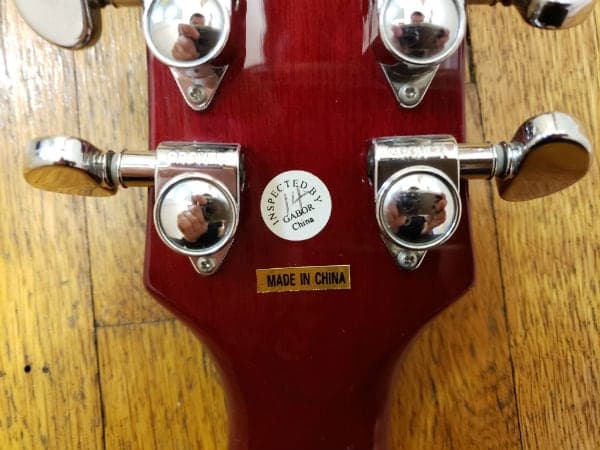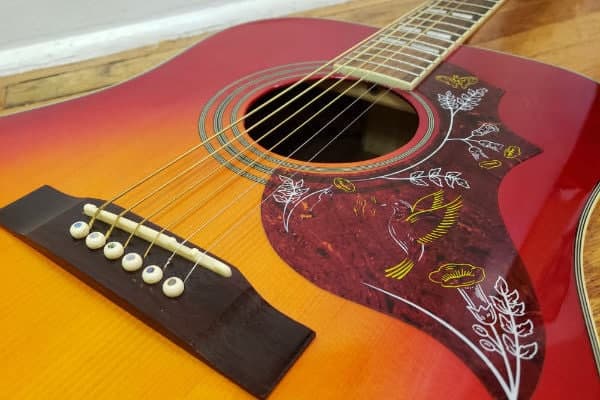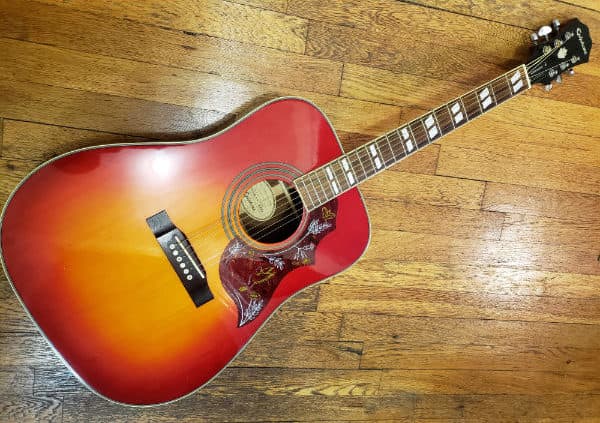I’ve had my Hummingbird for about a decade now, and it’s been a consistent presence in my recordings. Before we add it to Alroight Bab, let’s take a minute to have a proper nosey at it.
The Hummingbird was first released in the sixties, so named for the design of its pickguard. Noel Gallagher sometimes uses one, which might go some way in explaining its desirability to me.
Background
As noted in the initial rig run down, this Hummingbird has an odd little story behind it, and how it came to be in my possession.
A friend of mine bought it for her boyfriend for Christmas. However, he broke up with her before Christmas, so it lay in her parents’ attic for a couple of year I think. Horrified by the waste of a good guitar, I gave her a couple of hundred UK pounds for it.
As I recall, I originally planned to add a pickup, and bodger it into an electro-acoustic. But I decided that I’d screw it up, and I couldn’t afford to get somebody else to do it. So, it ended up being my ‘nice’ guitar for recording with.

Epiphone Hummingbird: specs
| Country of origin | China |
| Construction type | Full-size dreadnought |
| Body material | Sitka spruce and mahogany |
| Neck material | Mahogany |
| Fingerboard material | Rosewood |
| Number of frets | 21 |
| Electronics | None on this one |
There isn’t anything groundbreaking or surprising there. No more than was noted after running through the specs of the axe bass, the Hummingbird relies somewhat on its looks.
Parts
The best thing about the parts on this Hummingbird is the use of Grover tuners.
Although this isn’t an expensive guitar by any stretch, it’s nice to see a manufacturer spend a few extra cents on tuners with a solid reputation for reliability. This is a feature right across Epiphone’s range.
The woods in use are standard by any stretch. But this particular guitar is made in China, so let’s not pretend for a second that it uses the best cuts of mahogany, sitka spruce, or rosewood.
Ouch! That seemed like a snarky remark about eastern-made guitars. But this is from the late 00s, when guitars from that direction had drastically improved from when I was a nipper. And let’s be realistic: a brand name like Epiphone, that’s part of Gibson will definitely have sufficient quality control in place to make sure garbage isn’t getting shipped.

Construction
Construction quality has never been an issue with Epiphone. They managed to keep up with the increased quality of guitars coming from the east over the past decade or so.
The neck joint is a typical, acoustic neck joint. It’s been tidy since I’ve owned it. I like the bind that runs down the neck and fingerboard. It’s pretty. It’s also smooth, and doesn’t cause any discomfort when I play
The split parallelograms in the fingerboard are cool. I know not every player shares that perspective! To me, it gives the craftsmanship that went into the guitar just a bit of a edge over standard dots.
This Epiphone guitar – perhaps unsurprisingly – comes with an Epiphone headstock. Ta-da! A simple truss rod cover and the crown inlay. Those Grover tuners sit tidy and tight on the back.
Tones
Obviously, we’ll get to consider the tones in more detail in the next post, where, we’ll be recording the Hummingbird.
The main reason for the Hummingbird’s consistent popularity since the 60s is likely how rounded the tone is. It’s an ideal middle of the road sound – not too bright or too heavy. Of course, it depends on things like what strings you’re using, and what state they’re in. It’s a mellow warmth. Like an acoustic equivalent to a Les Paul.
Here’s an example from the track I’m currently working on, Alroight Bab.

Playability
I mean, you can probably guess that I find this pretty playable. That’s why I’ve had it for a decade. I feel like the action is a little higher than other guitarists might like, but it’s not too expensive of a fix if it bothers them that much.
Unless you’re super-quiet, singers should be able to comfortably sing over its natural volume. Its sound is also versatile, and if I ever needed an acoustic guitar for a metal track, I wouldn’t hesitate to grab my Hummingbird.
Conclusion
This is such a good all-rounder of a guitar. From casual intermediate players in their living room, to recording guitars.
It looks the business, and feels and sounds great for the price, all of which makes an ideal addition to your light audio recording setup.
You can’t ask for much better than that!

If you found this helpful, subscribe on the right hand side of this page. You’ll be notified when new posts go live on Thursdays, so you can be inspired ahead of the weekend. Also, feel free to shoot me a coffee!